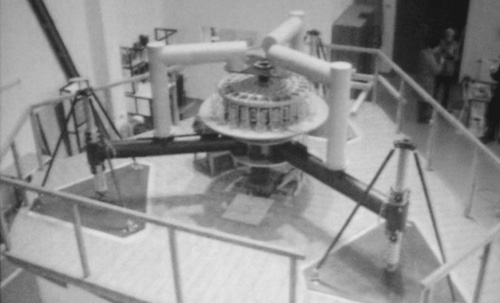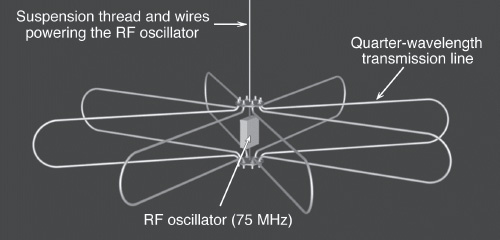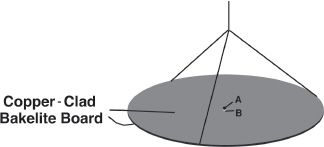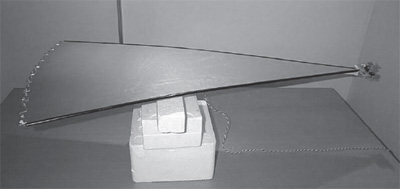Secrets of Antigravity Propulsion (45 page)

This inertial-mass-alteration effect has been demonstrated in the laboratory.
Kazakhstan physicist Valery Mikhailov conducted two experiments in which he observed the oscillation frequency of an electron located within a charged sphere.
In one, the sphere’s potential was varied between –3,000 volts and +3,000 volts, and in the other, the sphere’s potential was varied between –125 kilovolts and +125 kilovolts.
25,
26
He found that the electron’s effective inertial mass changed in direct proportion to the applied voltage potential—decreasing with increasing negative potential and increasing with increasing positive potential.
This is in agreement with the predictions of subquantum kinetics.
That is, by negatively charging the sphere, the gravity potential in the interior of the sphere should be raised; hence, the inertial mass of particles in the sphere’s interior should be decreased, as was observed.
Apparently unaware of subquantum kinetics, Mikhailov cited his results as confirmation of a different theoretical prediction, made by Brazilian physicist André Assis on the basis of force field interactions predicted by the electrodynamic approach of the ninteenth-century German physicist Wilhelm Weber.
27
Assis’s interpretation of Weber’s electrodynamics theory, however, makes the different prediction that the sign of this inertial effect should depend on the particle’s electric charge; hence, a proton’s inertial mass should increase when the sphere is negatively charged.
Subquantum kinetics, on the other hand, predicts that the proton’s inertial mass, like that of the electron, should decrease with increasing negative charge.
Apparently, another experiment should be performed on the oscillation frequency of a positively charged ion to determine which of these two theories is correct.
Meanwhile, we currently have only anecdotal reports on the behavior of the SEG to suggest that the subquantum kinetics alternative may be the correct outcome.
Yet another prediction coming out of subquantum kinetics concerns the phenomenon of dematerialization.
It predicts that if a spacecraft’s gravity potential was to rise very high, the craft could become invisible or, in some cases, could dematerialize all together.
In such a case, an increase in gravity potential above a certain critical threshold, g
c
, would dictate subcritical conditions in the ether reaction system, which in the extreme would cause energy waves and matter to ultimately dissipate, leaving behind uniform concentrations (i.e., the vacuum state).
Further experimental evidence is needed to determine whether this could account for observations of spacecraft invisibility.
The analysis presented above for the MEC would apply equally well to Searl’s multiring SEGs.
Since a second added ring would rotate in the same direction as the first but would be rotating twice as fast and clockwise relative to the innermost runner ring, the gravitic effects of the two rings would be additive, effectively doubling the weight loss of the apparatus at a given rotation rate.
This can be compared to operating two water pumps in series.
The inner ring of roller magnets would pump G-ons outward and the outer roller magnet ring would further assist this pumping action.
Adding a third ring would boost this effect even more.
Compared with the beam propulsion technology discussed in chapters 7 and 8, the SEG and the MEC appear to offer a simpler approach to gravitational levitation.
However, it may not be as desirable from a weaponry standpoint in that a craft using such levitation would not be able to abruptly change its direction of flight.
This may explain why the military has preferred the beam propulsion technology, since high-speed maneuverability would give a craft a distinct advantage in combat.
For more-peaceful applications, such as for high-speed personal transport across the globe or beyond to other planets, the SEG and MEC technology appears to be the better choice.
It also has the benefit of offering a virtually limitless energy source that could ultimately eliminate global warming.
Power companies, however, will need to reeducate themselves rapidly on basic physics and engineering so as not to follow the police-state tactics of their predecessors.
For example, in May 1982, government agents broke into Searl’s home, confiscated an SEG unit that was under test supplying electricity to his house, and tore out all the electrical wiring from his house.
Citing as evidence a sequence of unusually low metered electrical bills, the Southern Electricity Board then prosecuted him on trumped-up charges of “stealing electricity by means of a unique device,” and sued him for a large sum of money.
As a result, Searl’s family broke up and he became very depressed.
The Court had him confined to jail for about a year and while so detained an arsonist set his house on fire, destroying most of his records and equipment.
28

Figure 10.17.
The second magnetic energy converter prototype in the process of being assembled by Roschin and Godin in Moscow.
Roshchin and Godin do not presently have access to their earlier generator.
Reminiscent of Searl’s plight, they report that their first prototype was stolen from their laboratory.
However, they are currently working on building a second prototype at the Glushko “NPO Energomash” Company in Moscow with the intention of duplicating their earlier results (figure 10.17).
Groups led by Searl in the United Kingdom and by American researcher John Thomas in the United States are also undertaking projects that intend to duplicate Searl’s earlier work.
11
ELECTROGRAVITIC WAVE EXPERIMENTS
11.1 • THE DIMITRIOU GRAVITY SHIELD
Stavros Dimitriou, a professor of electrical engineering, has performed an experiment that may demonstrate some degree of gravity shielding.
Like the SEG, the weight-loss effect produced by Dimitriou’s apparatus appears to arise because electrons are induced to move radially in and out from a central point in a plane oriented perpendicular to the Earth’s gravity field.
Dimitriou arranged a set of eight wire loops in a radial pattern, the loops’ ends being joined at upper- and lower-hub junctures (see figure 11.1).
1
The entire “antenna,” which has a diameter of about 90 centimeters, was suspended from the ceiling by means of a thread.
A 15-volt, square-wave pulse signal having a frequency of about 75 megahertz was applied across the antenna’s upper and lower hubs to excite currents to oscillate back and forth through the wire loops.
These currents would flow radially with respect to the hubs and for the most part parallel to the Earth’s surface.
Dimitriou was supplying a radio-frequency power of only 2.5 watts to his antenna.
In order to maximize the current flowing in the loops, the excitation frequency was chosen to match the antenna’s resonant frequency, at which a quarter of a wavelength would fit across the loop’s approximately 1-meter radius.
At resonance, the currents circulating in the loops would be far higher than the AC exciting current, with maximum values being reached at the antenna’s periphery.
For example, if his loop system had a Q-resonance quality factor of 90, the 100-milliamp AC signal would have excited currents reaching up to 9 amperes.

Figure 11.1.
The gravity screening radio-frequency antenna array tested by Stavros Dimitriou.
(Adapted from a drawing on Jean-Louis Naudin’s website,
http://jnaudin.free.fr/
)
Dimitriou measured the antenna’s ability to alter gravity by swinging it back and forth on its suspending thread and measuring its period of oscillation, with the AC turned both on and off.
Comparing the periods, he found that the antenna’s swing period was slightly greater when the AC was on.
Since the length of the antenna’s suspending cord did not change, he concluded that the antenna was able to locally reduce the gravitational accelerating force by 1.3 percent, with the period of any swing of the pendulum being determined by its length and the force of gravity acting on its mass.
*34
He believed that this reduction arose because currents induced in the loops were somehow creating a local gravity-shielding effect.
He also swung a small pendulum bob that he held near the radio-frequency antenna and, by timing its swing, found that its period also increased when the antenna was excited.
2
Consequently, he concluded that objects in the immediate vicinity of the antenna were similarly affected by the gravity reduction.
The question that arises, however, is whether the reported percentage of reduction in the gravitational acceleration,
g
, is a real effect or a statistical artifact.
There is considerable error involved in measuring the period of a pendulum.
Even with no variation of the gravitational force or the pendulum length, the clocked period of the bob’s swing can vary from one clocked period to the next due to friction in the pendulum string, room air currents, and timing inaccuracies.
Consequently, such a pendulum period measurement has meaning only if many sets of measurements are made with the AC signal both turned on and turned off, for which period averages and period standard deviations are calculated.
If the difference between the average length of the “on” periods and the average length of the “off” periods is shown to be significantly greater than the data standard deviation, then one might surmise that a real effect on gravity is present.
But past reports of the existence of a g reduction effect may instead be misinterpreting statistical artifacts of the measurement process as evidence of a real effect.
French researcher Jean-Louis Naudin attempted to duplicate Dimitriou’s pendulum antenna experiment.
3
He built a similar wire loop array and excited it at a resonant frequency of 83 megahertz.
Whereas Dimitriou had used a handheld stopwatch to clock the antenna swing period, Naudin allowed the antenna pendulum to cut the path of a laser beam as it swung and recorded the swing intervals electronically.
Measuring the period increase of the pendulum swing, he calculated a much greater, 7 percent reduction in gravitational acceleration when the oscillator was switched on.
In another version of the experiment, Naudin tested the period swing of an antenna having wire loops that each included an extra turn at its outer extremities, with the extra loops being oriented in the horizontal plane.
With this design, Naudin measured an 11 percent reduction in gravitic force, for a power consumption of about 3.5 watts.
Both test rigs were found to have a Q value of about 10.
*35
However, like Dimitriou, Naudin reported only an estimated percentage of gravitational reduction, without providing the standard deviation values to allow one to judge the accuracy of the method of measurement.
Thus, until a test of the radio frequency (RF) pendulum antenna is properly performed giving the purported RF-induced period change along with the variance of the period measurement, it is not possible to determine for certain if the effect is real.
All that can be said at present is that it is an interesting subject for investigation.
Dimitriou also proposed another version of his RF pendulum antenna experiment in which the wire loops of his antenna are replaced by a disc-shaped printed circuit board having copper-clad upper and lower surfaces electrically joined at its periphery (figure 11.2).
4
In this way, the two surfaces would form a pancake-shaped RF cavity that would have a beneficial high Q value.
He proposed that the lift effect would be more easily seen by testing a 30-degree pie section of the disc and observing its tilt when energized with radio-frequency power, given that a greater weight loss would be obtained at the sector’s periphery than at its center.
Naudin has attempted to duplicate Dimitriou’s RF pie-wedge experiment.
The wedge shown in figure 11.3 was balanced around its center of gravity and checked for evidence of any tilt when energized with a radio-frequency-exciting circuit connected at its apex.
Naudin reported that he was able to get some weak upward movements of the wedge’s rim, but that these movements were not easily reproducible.
In 2007, I witnessed several tests of the disc version of the Dimitriou RF pendulum antenna being resonantly excited with 20-volt pulses, but in my opinion there was no change of the pendulum’s period above the margin of measurement error; hence, no clear indication that gravity was being reduced when the disc was energized.
If there was an effect, it was too slight to be detected.
By accurately recording large numbers of pendulum swing periods, it should be possible to substantially reduce the variance in the period measurement data, in which case the sensitivity of the test to detecting small alterations in gravity might be improved.
If future tests demonstrate that a gravity-screening effect is produced, this would be one of the most promising among electrogravitic technologies, not only because of its simplicity, but also because of its high energy efficiency.

Figure 11.2.
The disc-shaped RF antenna proposed by Dimitriou in 2001.
The upper- and lower-disc surfaces would be energized with radio-frequency power near points A and B.

Figure 11.3.
A wedge-shaped printed circuit board constructed by Naudin as a test of Dimitriou’s experiment.
(Courtesy of J.-L.
Naudin, from his website,
http://jnaudin.free.fr/
)
Although it may be too early to theorize about how Dimitriou’s wire and disc antennae might produce a gravity-screening effect, we might venture an explanation similar to that given for the operation of the Searl disc.
That is, one might expect a gravity-screening effect to arise because G-ons are being induced to move in a horizontal direction (i.e., perpendicular to the Earth’s gravity field gradient).
The AC resonance in the antenna would set up oscillating electric potential field gradients directed radially inward and outward along the length of the upper or lower conductor wires.
Alternatively, in the case of the RF disc, these would be directed radially to and from the centers of upper or lower disc surfaces.
These oscillating field gradients would be steepest near the periphery of the wire loops (or disc surfaces), where the induced currents would also be maximal.
According to subquantum kinetics, these oscillating electric fields would be accompanied by oscillating gravity potential fields whose field gradients would also be maximal at the loop or disc periphery.
Consequently, the radial back-and-forth movement of electrons would be accompanied by a horizontal radial back-and-forth movement of G-ons.
The oscillating gravity field propelling these G-ons in the horizontal plane would also entrain G-ons associated with the vertical G-on flux that naturally flows toward the Earth in response to the Earth’s gravity field gradient.
Consequently, in the vicinity of this oscillating electrode, the ambient G-on flux and its associated G-on concentration gradient would be deflected from their normal vertical orientation toward the horizontal.
As a result, objects in the vicinity of this disc would no longer feel the full downward pull of the Earth’s gravity, being effectively screened from this field by the disrupting effect of this AC resonator.
In the Searl disc, the pulsing fields were nonreversing and always induced G-ons (and electrons) to move radially outward toward the periphery of the disc.
In that case, then, an occupant of such a vehicle would feel a centripetal inward-pulling gravitational force.
In a gravity shield created by radio-frequency excitation of a Dimitriou antenna, on the other hand, the direction of this radial G-on flux would reverse 100 million times per second or so.
Consequently, the horizontal gravity field component would have a net-zero value.
Brown may have inadvertently been producing such a gravity-screening effect in his vertical-lift electrokinetic apparatus.
His electrokinetics patent proposed applying AC to a negatively charged “half-wave radiator” disc electrode positioned at the tip of a conical dielectric (see figure 3.8 in chapter 3).
Like Dimitriou’s disc, this would have propelled G-ons radially inward and outward in the plane of the disc and set up a gravity-screening field in the electrode’s immediate vicinity.
The induced G-on flux would have locally redirected the G-on flux that normally moves downward toward the Earth to flow in a horizontal direction, thus decreasing the gravity field gradient across the saucer and locally reducing the g-value affecting the saucer’s mass.
The AC oscillations induced in the positively charged canopy electrode would also have contributed to the gravity-screening effect.
Thus, part of the lift that Brown was getting might be attributed to an induced gravity-screening effect.